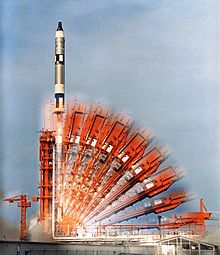This article needs additional citations for
verification. (April 2021) |
 A multiple exposure photograph of the configuration of Pad 19 up until the launch of
Gemini 10. | |||||||||||
|
| |||||||||||
| Launch site | Cape Canaveral Space Force Station | ||||||||||
|---|---|---|---|---|---|---|---|---|---|---|---|
| Location | 28°30′24″N 80°33′15″W / 28.50667°N 80.55417°W | ||||||||||
| Short name | LC-19 | ||||||||||
| Operator | US Space Force | ||||||||||
| Total launches | 27 | ||||||||||
| Launch pad(s) | 1 | ||||||||||
|
Orbital inclination range | 28° - 57° | ||||||||||
| |||||||||||
Launch Complex 19 (LC-19) is a deactivated launch site on Cape Canaveral Space Force Station, Florida used by NASA to launch all of the Gemini crewed spaceflights. It was also used by uncrewed Titan I and Titan II missiles. [1]
LC-19 was in use from 1959 to 1966, during which time it saw 27 launches, 10 of which were crewed. The first flight from LC-19 was on August 14, 1959 and ended in a pad explosion, extensively damaging the facility, which took a few months to repair. The first successful launch from LC-19 was also a Titan I, on February 2, 1960. After being converted for the Titan II ICBM program in 1962, LC-19 was later designated for the Gemini flights. After the program concluded in December 1966, LC-19 was closed down.
The Gemini white room from the top of the booster erector has been partially restored and is on display at the Air Force Space and Missile Museum located at Complex 26. [1]
Gallery
-
Diagram of Complex 19.
-
Diagram of the blockhouse at Complex 19.
-
LC-19 white room is in the right background, on display at the Air Force Space and Missile Museum.
-
The erector is lowered in preparation for the launch of Gemini 5.
See also
References
- ^ a b c "Cohort Program - Step Level 2" (PDF). NASA Safety Center. NASA. 20 February 2018. p. 3. Archived (PDF) from the original on 22 April 2021. Retrieved 22 April 2021.
![]() This article incorporates
public domain material from websites or documents of the
National Aeronautics and Space Administration.
This article incorporates
public domain material from websites or documents of the
National Aeronautics and Space Administration.




